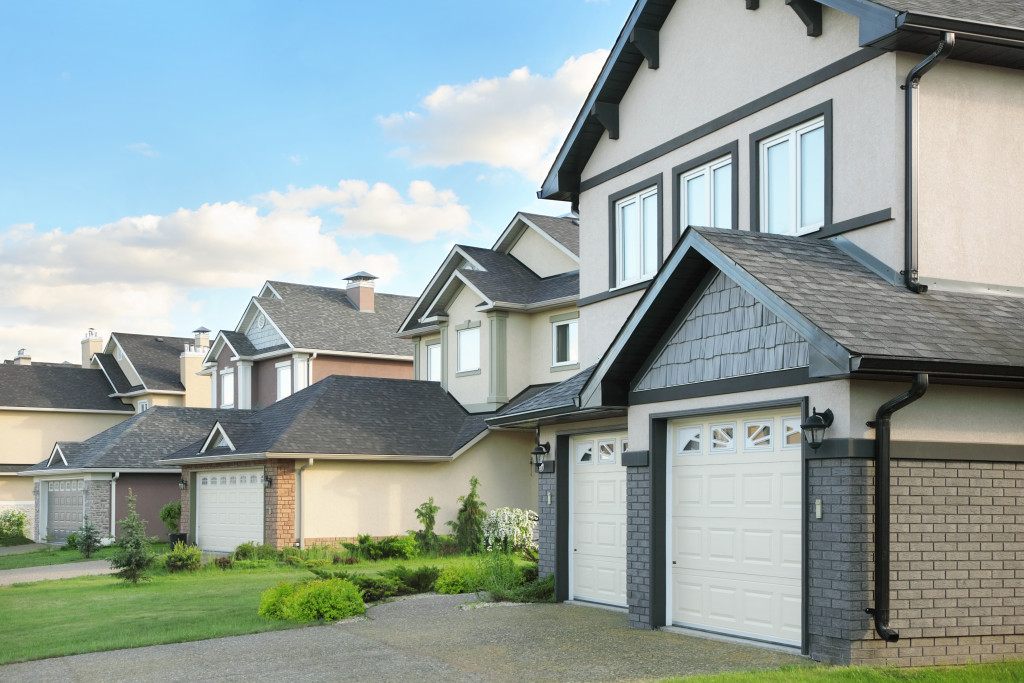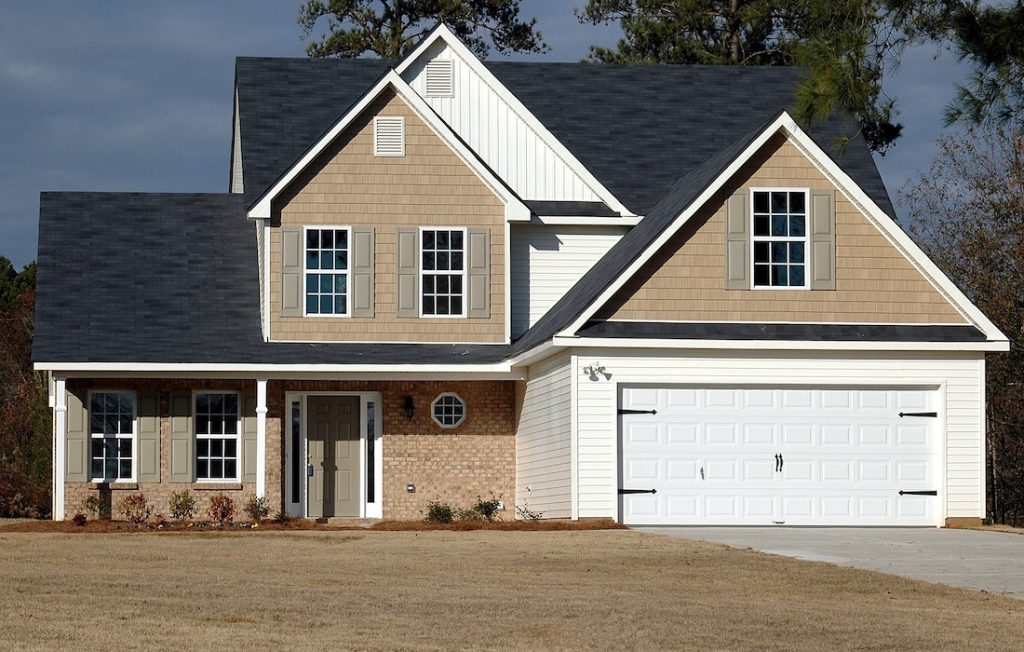In today’s world, vehicles have become a necessity for most people. According to Forbes data from 2021, 91.7% of households in the United States own at least one vehicle. With so many cars on the road, having a place to store them safely and securely is essential.
This part is where the ongoing debate between carport vs. garage comes into play. In several reports, approximately 66% of housing units have a carport or garage. Both provide a practical option for protecting your vehicle from the elements, such as rain, hail, and snow.

However, some critical differences between the two are worth considering. While carports provide a practical option, a garage offers more privacy. With a garage, your vehicle is well-protected from not just the weather but also from prying eyes. Additionally, a garage can provide extra storage space for tools, bicycles, and other equipment.
But privacy can also be an issue in a garage if the garage doors are not well-adjusted. A malfunctioning garage door can be a security risk, leaving your vehicle vulnerable to theft or damage. That’s why knowing how to adjust a garage door is essential to ensure your car’s and belongings’ security.
Whether you are a DIY enthusiast or simply looking to save money on garage door repairs, this article will provide the knowledge you need to keep your garage door functioning as it should.
Tools Required for Adjusting a Garage Door
When adjusting your garage door, having the right tools is essential. Investing in garage essentials, particularly tools, can save you time and money in the long run. With the right tools, you can quickly diagnose and fix common garage door problems, ensuring your garage door is functioning correctly and safely.
Having the right tools when adjusting your garage door can help ease your project by making it easier to access hard-to-reach parts and providing the necessary leverage and torque to make adjustments. It can also help you avoid damaging your garage door or its components while making adjustments. Here is a list of tools you will need to adjust your garage door:
- Screwdriver: A screwdriver is a primary tool that you will need to adjust screws and fasteners on your garage door. This tool comes in various sizes and shapes, so choose one that will fit the screws on your garage door.
- Socket wrench: A socket wrench is a versatile tool allowing you to remove nuts and bolts from your garage door. It comes in various sizes and can be adjusted to fit different bolt sizes.
- Adjustable wrench: An adjustable wrench is another essential tool that you will need to adjust nuts and bolts on your garage door. It can be adjusted to fit different sizes of nuts and bolts.
- Pliers: Pliers help hold and manipulate small parts of your garage door. You can use them to hold screws and nuts while tightening or loosening them.
- Pry bar: A pry bar is a useful tool for removing stubborn parts on your garage door.
- Level: A level is essential for ensuring that your garage door is balanced correctly and level. You can use this tool to adjust the balance and make necessary adjustments.
- Lubricant: A lubricant such as WD-40 can help lubricate moving parts on your garage door and prevent rust and corrosion.
- Safety glasses: Safety glasses protect your eyes from debris and dust while working on your garage door.
- Ladder: A ladder will help you access hard-to-reach parts of your garage door and allow you to work safely at height.
Safety Precautions
Adjusting a garage door is about fixing its mechanical components and ensuring your safety. Garage doors are heavy and have many moving parts, which can cause injury if not handled carefully. Therefore, it is essential to take safety precautions to protect yourself from potential accidents. Below are some safety precautions to take before adjusting a garage door:
- Turn off the power: Before adjusting your garage door, turn off the power to the garage door opener. This step will prevent the door from accidentally opening or closing while you’re working on it.
- Wear protective gear: Wear protective equipment such as safety glasses, work gloves, and appropriate clothing to prevent injuries while adjusting the garage door.
- Use a ladder: Use a stable ladder to access the garage door components safely. Be sure to place it on a level surface and lock it securely in place.
- Disconnect the door opener: If you’re planning to adjust the garage door springs or cables, disconnect the door opener from the door first. Doing so will prevent the door from moving unexpectedly while working on it.
- Keep children and pets away: Keep children and pets away from the garage area while working on the door. They may accidentally cause the door to move or get in the way, causing injury.
- Follow the manufacturer’s instructions: Follow the manufacturer’s instructions for adjusting the garage door. Each garage door model may have different adjustment procedures, so it’s essential to read the manual before attempting any repairs.
Types of Garage Door Adjustments

There are several types of garage door adjustments that may be necessary to ensure your garage door is functioning correctly. These adjustments include the following:
- Track alignment adjustment: If the garage door tracks are not perfectly aligned, it can cause the door to bind or even come off the tracks. Adjusting the tracks can ensure that the door moves smoothly and evenly. You can do this by loosening the bolts on either side of the tracks and adjusting them until they are level.
- Spring tension adjustment: The garage door springs are critical in counterbalancing the door’s weight. If the spring tension is too tight or too loose, it can cause the door to open or close too quickly, creating safety hazards. Therefore, it might be time to adjust the spring tension to ensure the door operates safely and smoothly.
- Limit switch adjustment: The garage door limit switches control how far the door travels when opening and closing. If the limit switch is not well-set, the door may not open or close all the way, or it may reverse unexpectedly. So, it is essential to adjust the door opener’s limit switch to ensure that it fits the length of your garage door.
- Weatherstripping adjustment: Weatherstripping helps seal the garage door, preventing drafts and debris from entering your garage. When you notice the weatherstripping is damaged or not aligned correctly, it’s time to make adjustments. Replace any worn or damaged strips and adjust the existing ones to ensure they are correctly in place. Doing so will prevent outside elements from entering your garage and improve the overall security of your home.
- Lubrication adjustment: Lubrication helps reduce friction between moving garage door components, prolonging the door’s lifespan and preventing damage. If the door makes excessive noise or moves jerkily, it may be time to lubricate the moving parts. Adjusting the lubrication can ensure that the garage door operates quietly and smoothly.
Steps for Adjusting a Garage Door
Adjusting a garage door can seem daunting, but with the right tools and knowledge, it can be a straightforward process. Here are the steps for adjusting a garage door:
- Inspect the garage door: Before adjusting the garage door, inspect the door’s components, including the tracks, springs, rollers, and cables. Look for any damage or signs of wear that may require repairs or replacement.
- Release the garage door from the opener: Pull the release handle or cord on the garage door opener to disengage the door from the opener. This step is crucial to prevent accidents or damage during the adjustment process.
- Adjust the track alignment: If the garage door tracks are misaligned, use a level to adjust them. Loosen the screws holding the tracks in place and gently tap them into the correct position. Tighten the screws to secure the tracks.
- Adjust the spring tension: Adjusting the spring tension requires caution, as it can be dangerous. Use a winding bar to adjust the tension on the springs, making minor adjustments at a time. Test the door after each adjustment to ensure it is not too loose or too tight.
- Adjust the limit switches: The limit switches to control how far the door travels when opening and closing. Adjust them using the manufacturer’s instructions to ensure the door operates correctly.
- Adjust the weatherstripping: If it is damaged or not aligned correctly, adjust it to ensure it seals the door perfectly. Replace any damaged weatherstripping.
- Lubricate the moving parts: Lubricate the moving parts, including the rollers, hinges, and tracks, with garage door lubricant. This step can reduce friction and noise and extend the door’s lifespan.
- Test the door: Test the garage door to ensure it operates correctly. Repeat the adjustment process or call a professional for help if it still does not work correctly.
Common Mistakes to Avoid
Adjusting a garage door requires careful attention to detail and patience to ensure that the door operates correctly. However, mistakes can happen during the adjustment process that can cause further damage or safety hazards. The following are some common mistakes to avoid when adjusting your garage door:
A. Adjusting the Tracks
One of the most common issues with garage doors is misaligned tracks. To adjust the tracks, use a level to ensure that they are even, and then loosen the screws holding the tracks in place. Gently tap the tracks into the correct position and then tighten the screws.
Avoid overtightening the screws, which can cause the tracks to bend or break. Instead of forcing the tracks, use a level to adjust them gently. If the tracks are damaged, consider replacing them to avoid further issues.
B. Adjusting the Springs
Garage doors rely on springs to help lift and lower the door. Over time, these springs can lose tension or become damaged, causing the door to operate incorrectly. To adjust the springs, use a winding bar to make small adjustments. However, be cautious, as adjusting the springs can be dangerous.
One common mistake is adjusting the springs without securing them properly. Before adjusting the springs, secure them with a winding bar to prevent injury. Make minor adjustments and test the door after each one to ensure it operates correctly.
It’s also essential to know what type of springs your door has and when they may require adjustment. For instance, torsion springs may require more frequent adjustments than extension springs. So, it’s crucial to understand the differences and follow the manufacturer’s instructions for the best results.
C. Adjusting the Opener
The garage door opener controls the door’s movement, and issues with the opener can cause the door to operate incorrectly. To adjust the opener, refer to the manufacturer’s instructions. Common issues with openers include loose wires or misaligned sensors. These can be easily fixed by tightening the wires and adjusting the sensors.
Before making any adjustments to the opener, turn off the power to prevent electrical shock. Many openers have an emergency release cord that can disconnect the opener from the door. You can then adjust the opener safely.
D. Lubricating the Garage Door
One mistake homeowners often make is neglecting to lubricate the garage door. Lubrication is crucial for the door’s smooth operation and longevity. When lubricating the garage door, apply the right products to the moving parts, including the rollers, hinges, and tracks. Recommended options are WD-40 or a silicone-based lubricant.
Making adjustments to your garage door is an essential part of its maintenance and upkeep. Proper adjustments can help prevent safety hazards and prolong the life of the door. However, taking safety precautions and avoiding common mistakes is essential when making adjustments. Additionally, seek professional help if you are unsure how to make adjustments safely or if the issues with your garage door are beyond your expertise.

Bottom Line
Investing in your garage door’s maintenance and upkeep can save money and prevent safety hazards in the long run. By following the proper steps and taking the necessary safety precautions, you can ensure that your garage door operates smoothly and safely for years to come. So, get started on the task today and keep your garage door in top shape.



